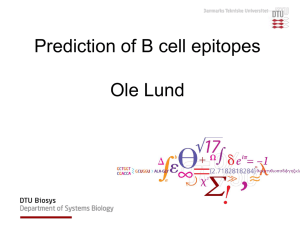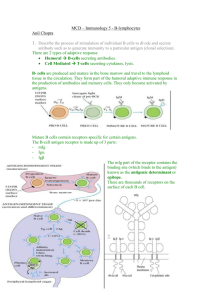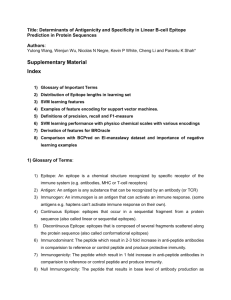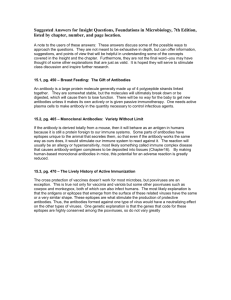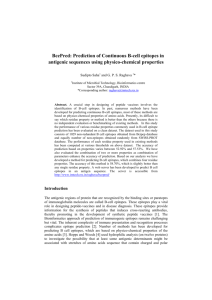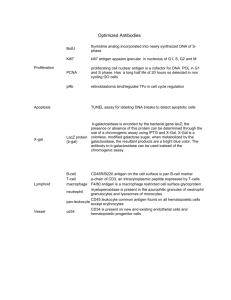Predicting Protective Linear B-cell Epitopes
advertisement
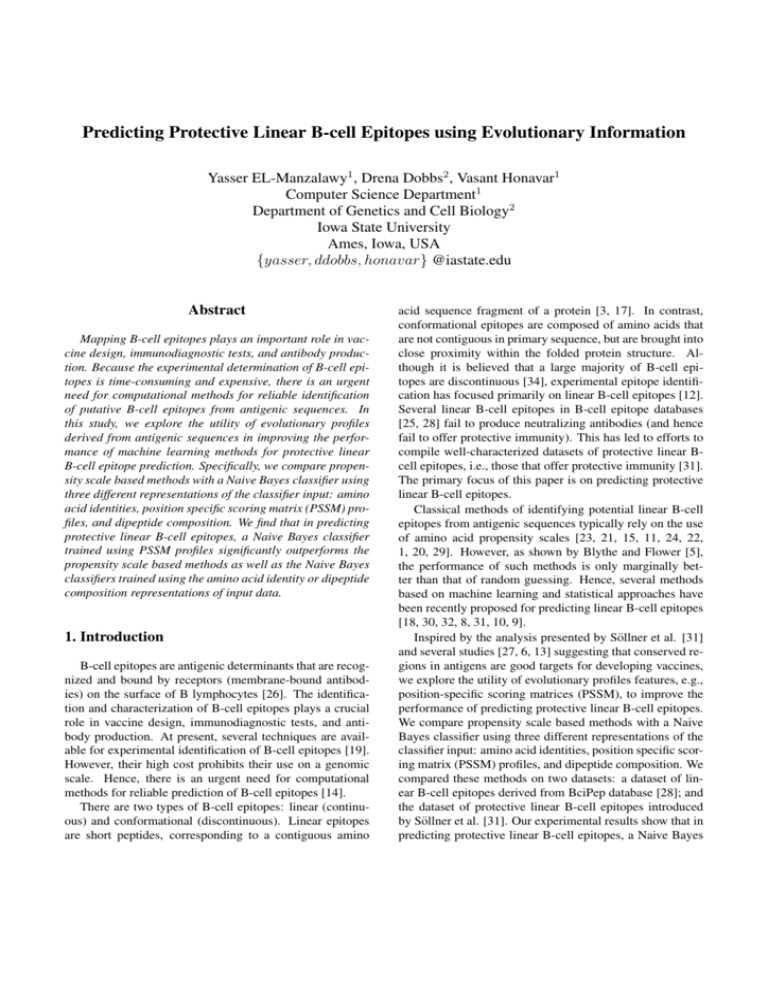
Predicting Protective Linear B-cell Epitopes using Evolutionary Information
Yasser EL-Manzalawy1 , Drena Dobbs2 , Vasant Honavar1
Computer Science Department1
Department of Genetics and Cell Biology2
Iowa State University
Ames, Iowa, USA
{yasser, ddobbs, honavar} @iastate.edu
Abstract
Mapping B-cell epitopes plays an important role in vaccine design, immunodiagnostic tests, and antibody production. Because the experimental determination of B-cell epitopes is time-consuming and expensive, there is an urgent
need for computational methods for reliable identification
of putative B-cell epitopes from antigenic sequences. In
this study, we explore the utility of evolutionary profiles
derived from antigenic sequences in improving the performance of machine learning methods for protective linear
B-cell epitope prediction. Specifically, we compare propensity scale based methods with a Naive Bayes classifier using
three different representations of the classifier input: amino
acid identities, position specific scoring matrix (PSSM) profiles, and dipeptide composition. We find that in predicting
protective linear B-cell epitopes, a Naive Bayes classifier
trained using PSSM profiles significantly outperforms the
propensity scale based methods as well as the Naive Bayes
classifiers trained using the amino acid identity or dipeptide
composition representations of input data.
1. Introduction
B-cell epitopes are antigenic determinants that are recognized and bound by receptors (membrane-bound antibodies) on the surface of B lymphocytes [26]. The identification and characterization of B-cell epitopes plays a crucial
role in vaccine design, immunodiagnostic tests, and antibody production. At present, several techniques are available for experimental identification of B-cell epitopes [19].
However, their high cost prohibits their use on a genomic
scale. Hence, there is an urgent need for computational
methods for reliable prediction of B-cell epitopes [14].
There are two types of B-cell epitopes: linear (continuous) and conformational (discontinuous). Linear epitopes
are short peptides, corresponding to a contiguous amino
acid sequence fragment of a protein [3, 17]. In contrast,
conformational epitopes are composed of amino acids that
are not contiguous in primary sequence, but are brought into
close proximity within the folded protein structure. Although it is believed that a large majority of B-cell epitopes are discontinuous [34], experimental epitope identification has focused primarily on linear B-cell epitopes [12].
Several linear B-cell epitopes in B-cell epitope databases
[25, 28] fail to produce neutralizing antibodies (and hence
fail to offer protective immunity). This has led to efforts to
compile well-characterized datasets of protective linear Bcell epitopes, i.e., those that offer protective immunity [31].
The primary focus of this paper is on predicting protective
linear B-cell epitopes.
Classical methods of identifying potential linear B-cell
epitopes from antigenic sequences typically rely on the use
of amino acid propensity scales [23, 21, 15, 11, 24, 22,
1, 20, 29]. However, as shown by Blythe and Flower [5],
the performance of such methods is only marginally better than that of random guessing. Hence, several methods
based on machine learning and statistical approaches have
been recently proposed for predicting linear B-cell epitopes
[18, 30, 32, 8, 31, 10, 9].
Inspired by the analysis presented by Söllner et al. [31]
and several studies [27, 6, 13] suggesting that conserved regions in antigens are good targets for developing vaccines,
we explore the utility of evolutionary profiles features, e.g.,
position-specific scoring matrices (PSSM), to improve the
performance of predicting protective linear B-cell epitopes.
We compare propensity scale based methods with a Naive
Bayes classifier using three different representations of the
classifier input: amino acid identities, position specific scoring matrix (PSSM) profiles, and dipeptide composition. We
compared these methods on two datasets: a dataset of linear B-cell epitopes derived from BciPep database [28]; and
the dataset of protective linear B-cell epitopes introduced
by Söllner et al. [31]. Our experimental results show that in
predicting protective linear B-cell epitopes, a Naive Bayes
classifier trained using PSSM profiles significantly outperforms the propensity scale based methods as well as the
Naive Bayes classifiers trained using the amino acid identity
or dipeptide composition representations of the data.
2. Materials and Methods
2.1
Datasets
We used two datasets in this study:
1. Protectivity dataset [31], which is, to the best of
our knowledge, the first and only available dataset
of protective linear B-cell epitopes. This dataset is
comprised of 57 non-redundant pathogen proteins extracted from IEDB database [25]. Each of these 57
antigens is annotated with a number of linear B-cell
epitopes that are classified as “leading to biological
activity”. The resulting dataset of B-cell epitopes is
believed to closely approximate a dataset of protective
linear B-cell epitopes [31].
2. BciPep dataset, a dataset of 125 non-redundant antigens at 30% sequence similarity cutoff constructed
from BciPep database [28]. Peptide-based methods for
identifying linear epitopes utilize the target antigen for
deciding on a set of overlapping epitopes to be synthesized on pins (PEPSCAN), on a cellulose membrane
support (SPOT), or on micro-arrays [19]. The synthetic peptides are then being examined for antibody
binding. Hence, the presence of a purified antigen for
mapping of linear B-cell epitopes using peptide-based
methods is not required. Based on this observation of
the independence of antigen when identifying linear
B-cell epitopes, we label the residues in the 125 antigen sequences as follows: First, we collect a set of
1230 unique B-cell epitopes included in BciPep database. Then, we compare each protein sequence against
each epitope in the set of unique epitopes to find exact
matches. For each hit, we assign positive labels to antigen residues included in that match. Thus, if a reported
epitope sequence is repeated in an antigen sequence,
all occurrences of that epitope will receive positive labels. For example, this procedure assigns positive labels to each of the 25 occurrences of the synthetic epitope “TPSTPA” in the repetitive shed acute-phase antigen (SAPA) from Trypanosoma cruzi. Moreover, if an
epitope sequence x is reported to be in an antigen A
but it happens that x also occurs in an antigen B and
both A and B are in our dataset, then both occurrences
of x receive positive labels.
2.2
Feature representation
In our setup, the classifier receives a nine amino-acid
window as input. A label is assigned to the instance corresponding to the label of the residue at the center of the
window. A positive label indicates that the target residue,
the residue at the center of the window, is included in an
epitope. A negative label denotes that the target residue is
not included in any reported epitope.
We explore three alternative representations of the nine
amino acid windows: (i) Amino Acid Identity (ID) representation: Each 9-mer window is represented by an ordered
9-tuple of amino acids from the 20-letter amino acid alphabet; (ii) PSSM representation: Each antigen sequence in
the datasets is aligned against a non-redundant dataset of
all currently known sequences using PSI-BLAST [2] with
three iterations and cut-off at 10−3 . Each residue in the 9
amino acid window is then encoded using the (PSSM) matrix for that residue in the resulting PSSM profile. Thus,
each 9-mer window is represented by 9 × 20 feature vector;
(iii) Dipeptide composition (DC) representation: Dipeptide composition represent an amino acid sequence (of any
length) using the observation frequency for each possible
dipeptide in the given sequence. With 20 amino acid alphabet, each 9-mer window is represented by a feature vector
of 400 dimensions which correspond to the frequencies of
occurrence of each of the 20 × 20 possible dipeptides.
3. Results and Discussion
We compared the performance of the Naive Bayes classifiers using the sequence identity (NBID), PSSM profiles
(NBPSSM), and dipeptide composition (NBDC) representations of the data with five propensity scale based methods
[21, 15, 11, 24, 16] on the protectivity and BciPep datasets
using 5-fold sequence-based cross-validation [7]. The predictive performance measured by the area under the Reciever Operating Characteristic (ROC) curve is summarized
in Table 1. The ROC curves are shown in Figure 1.
In predicting protective linear B-cell epitopes, Parker’s
method [21] slightly outperforms the other four propensity scale based methods and even the Naive Bayes classifiers evaluated using sequence identity or dipeptide composition features; and Naive Bayes classifier evaluated using
the PSSM representation of the data outperforms all other
methods. NBPSSM ROC curve dominates the ROC curves
for each of the other methods.
In predicting linear B-cell epitopes, we find that all of the
five propensity scale based methods marginally outperform
random guessing (AUC=0.5). This result is consistent with
the results of Blythe and Flower’s study on a smaller dataset
of 50 proteins [5]. Perhaps more interesting is the finding
that none of the three Naive Bayes classifiers offer improve-
ments over the propensity scale based methods. Thus, the
ROC curves for all of the methods are close to a diagonal
connecting points (0,0) and (1,1) which corresponds to a
classifier that assigns labels by random guessing.
The superior performance of a Naive Bayes classifier
evaluated using PSSM-based data representation in predicting protective linear B-cell epitopes, underscores the
functional importance of sequence conservation (previously
noted by several authors [27, 6, 13, 31]). It also suggests
that conserved regions in antigenic sequences are good candidates to target for developing new vaccines. This possibility needs to be further explored by applying sequence
variability analysis methods [4, 13]. It is also worth noting
that highly variable sequence residues can be functionally
important [13]. PSSM profiles contain information that can
be used to distinguish highly conserved residues from those
that are not conserved and from those that are only moderately conserved. Hence, combining PSSM profiles with
machine learning methods provides a powerful tool for discovering useful patterns for predicting functionally important residues without the need for any a-priori assumptions
regarding the conservation or variability of the functional
residues.
Work in progress is aimed at further improving the performance of methods for protective B-cell epitope prediction by:
1. Incorporating feature selection, feature abstraction,
and dimensionality reduction methods to minimize the
deleterious effects of redundant and irrelevant features.
2. Exploring more sophisticated machine learning methods such as Support Vector Machine [33].
3. Exploring the utility of additional sequence-derived
features, e.g., predicted solvent accessibility (since linear B-cell epitopes are believed to be exposed to the
surface of the antigen).
References
[1] A. Alix. Predictive estimation of protein linear epitopes by
using the program PEOPLE. Vaccine, 18:311–4, 1999.
[2] S. Altschul, T. Madden, A. Schäffer, J. Zhang, Z. Zhang,
W. Miller, and D. Lipman. Gapped BLAST and PSIBLAST: a new generation of protein database search programs. Nucleic Acids Res, 25:3390–3402, 1997.
[3] D. Barlow, M. Edwards, J. Thornton, et al. Continuous
and discontinuous protein antigenic determinants. Nature,
322:747–748, 1986.
[4] C. Berezin, F. Glaser, J. Rosenberg, I. Paz, T. Pupko,
P. Fariselli, R. Casadio, and N. Ben-Tal. ConSeq: the identification of functionally and structurally important residues
in protein sequences. Bioinformatics, 20:1322–1324, 2004.
[5] M. Blythe and D. Flower. Benchmarking B cell epitope prediction: Underperformance of existing methods. Protein Sci,
14:246–248, 2005.
[6] H. Bui, J. Sidney, W. Li, N. Fusseder, and A. Sette. Development of an epitope conservancy analysis tool to facilitate
the design of epitope-based diagnostics and vaccines. BMC
Bioinformatics, 8:361, 2007.
[7] C. Caragea, J. Sinapov, V. Honavar, and D. Dobbs. Assessing the Performance of Macromolecular Sequence Classifiers. Proceedings of the 7th IEEE International Conference on Bioinformatics and Bioengineering, pages 320–326,
2007.
[8] J. Chen, H. Liu, J. Yang, and K. Chou. Prediction of linear B-cell epitopes using amino acid pair antigenicity scale.
Amino Acids, 33:423–428, 2007.
[9] Y. El-Manzalawy, D. Dobbs, and V. Honavar. Predicting Flexible Length Linear B-cell Epitopes. 7th International Conference on Computational Systems Bioinformatics (CSB’08), pages 121–132, 2008.
[10] Y. El-Manzalawy, D. Dobbs, and V. Honavar. Predicting
linear B-cell epitopes using string kernels. J Mol Recognit,
21:243–255, 2008.
[11] E. Emini, J. Hughes, D. Perlow, and J. Boger. Induction
of hepatitis A virus-neutralizing antibody by a virus-specific
synthetic peptide. J Virol, 55:836–839, 1985.
[12] D. Flower. Immunoinformatics: Predicting immunogenicity
in silico. Quantum distributor, 1st edition, 2007.
[13] M. Garcia-Boronat, C. Diez-Rivero, E. Reinherz, and
P. Reche. PVS: a web server for protein sequence variability analysis tuned to facilitate conserved epitope discovery.
Nucleic Acids Res, 36:W35, 2008.
[14] J. Greenbaum, P. Andersen, M. Blythe, H. Bui, R. Cachau,
J. Crowe, M. Davies, A. Kolaskar, O. Lund, S. Morrison,
et al. Towards a consensus on datasets and evaluation metrics for developing B-cell epitope prediction tools. J Mol
Recognit, 20:75–82, 2007.
[15] P. Karplus and G. Schulz. Prediction of chain flexibility in
proteins: a tool for the selection of peptide antigen. Naturwiss, 72:21–213, 1985.
[16] A. Kolaskar and P. Tongaonkar. A semi-empirical method
for prediction of antigenic determinants on protein antigens.
FEBS Lett, 276(1-2):172–4, 1990.
[17] J. Langeveld, J. martinez Torrecuadrada, R. boshuizen,
R. Meloen, and C. Ignacio. Characterisation of a protective
linear B cell epitope against feline parvoviruses. Vaccine,
19:2352–2360, 2001.
[18] J. Larsen, O. Lund, and M. Nielsen. Improved method for
predicting linear B-cell epitopes. Immunome Res, 2:2, 2006.
[19] G. Morris. Epitope Mapping: B-cell Epitopes. Encyclopedia
of Life Sciences, 2007.
[20] M. Odorico and J. Pellequer. BEPITOPE: predicting the location of continuous epitopes and patterns in proteins. J Mol
Recognit, 16:20–22, 2003.
[21] J. Parker and H. R. Guo, D and. New hydrophilicity scale
derived from high-performance liquid chromatography peptide retention data: correlation of predicted surface residues
with antigenicity and x-ray-derived accessible sites. Biochemistry, 25:5425–5432, 1986.
Table 1. AUC values for different prediction methods on protectivity and BciPep datasets using 5-fold
sequence-based cross-validation tests.
M ETHOD
PARKER H YDROPHILICITY
C HOU AND FASMAN B ETA -T URN
E MINI S URFACE ACCESSIBILITY
K ARPLUS AND S CHULZ F LEXIBILITY
KOLASKAR AND T ONGAONKAR A NTIGENICITY
NBID
NBPSSM
NBDC
P ROTECTIVITY
0.58
0.54
0.57
0.56
0.46
0.54
0.61
0.56
B CI P EP
0.56
0.56
0.55
0.54
0.46
0.54
0.55
0.54
Figure 1. ROC curves for different methods on protectivity (left) and BciPep (right) datasets estimated
using 5-fold sequence-based cross-validation.
[22] J. Pellequer and E. Westhof. PREDITOP: a program for
antigenicity prediction. J Mol Graph, 11:204–210, 1993.
[23] J. Pellequer, E. Westhof, and M. Van Regenmortel. Predicting location of continuous epitopes in proteins from their
primary structures. Meth Enzymol, 203:176–201, 1991.
[24] J. Pellequer, E. Westhof, and M. Van Regenmortel. Correlation between the location of antigenic sites and the prediction of turns in proteins. Immunol Lett, 36:83–99, 1993.
[25] B. Peters, J. Sidney, P. Bourne, H. Bui, S. Buus, G. Doh,
W. Fleri, M. Kronenberg, R. Kubo, O. Lund, et al. The Immune Epitope Database and Analysis Resource: From Vision to Blueprint. PLoS Biology, 3:e91, 2005.
[26] G. Pier, J. Lyczak, and L. Wetzler. Immunology, infection,
and immunity. ASM Press, 1st edition, 2004.
[27] P. Reche and E. Reinherz. Sequence Variability Analysis
of Human Class I and Class II MHC Molecules: Functional
and Structural Correlates of Amino Acid Polymorphisms. J
Mol Biol, 331:623–641, 2003.
[28] S. Saha, M. Bhasin, and G. Raghava. Bcipep: a database of
B-cell epitopes. BMC Genomics, 6:79, 2005.
[29] S. Saha and G. Raghava. BcePred: Prediction of continuous B-cell epitopes in antigenic sequences using physicochemical properties. Artificial Immune Systems, Third Inter-
[30]
[31]
[32]
[33]
[34]
national Conference (ICARIS 2004), LNCS, 3239:197–204,
2004.
S. Saha and G. Raghava. Prediction of continuous B-cell
epitopes in an antigen using recurrent neural network. Proteins, 65:40–48, 2006.
J. Sollner, R. Grohmann, R. Rapberger, P. Perco, A. Lukas,
B. Mayer, and M. Blythe. Analysis and prediction of protective continuous B-cell epitopes on pathogen proteins. Immunome Res, 2008:1–17, 2008.
J. Söllner and B. Mayer. Machine learning approaches
for prediction of linear B-cell epitopes on proteins. J Mol
Recognit, 19:200–208, 2006.
V. Vapnik. The nature of statistical learning theory.
Springer, 2nd edition, 2000.
G. Walter. Production and use of antibodies against synthetic
peptides. J Immunol Methods, 88:149–61, 1986.

